In summer 2007, after coming back from Portugal, mom went to Rome to take Italian classes for 2 weeks, and she took me with her. Just after arriving there, as it was Sunday, we decided to take a day trip to a nearby village called Tivoli, where there is Villa d'Este. This is a Renaissance palace with a garden where you can see lots of very beautiful fountains, like that Pegaso Fountain.
Esta es otra de las fuentes con estatuas de Villa d'Este. Se llama "Rometta" o sea "Romita", porque representa a una Roma en pequeño, con la estatua de la Roma Vittoriosa y la de la Loba Capitolina con Rómulo y Remo.
This is another fountain with statues of Villa d'Este. It's called "Rometta", or Little Rome, because it represents a little Rome. There is the statue of victorious Rome and also the Capitoline Wolf with Romulus and Remus.
En Tivoli también está Villa Adriana, mandada construir por el emperador romano Adriano en el siglo II. Ahora está en ruinas, pero es muy bonita e interesante. Este edificio se llama Teatro Marittimo, pero no es un teatro sino un edificio rodeado de un anillo de agua, seguro que sería como una casa con una piscina rodeándola, qué listos eran los romanos...
In Tivoli there is also Villa Adriana, which was built by the Roman Emperor Hadrian in the second century. It is now in ruins, but it is very nice and interesting. This building is called Teatro Marittimo. It's not a theater but a building surrounded by a ring of water. Surely it was like a house with a swimming pool around her, how clever were Romans ...
Al día siguiente empezamos viendo los restos monumentales de la antigua Roma. Me sentí pequeñísima delante del Coliseo (Colosseo en italiano, supongo que por sus dimensiones, ¡ es inmenso!). Mide 57 m de altura y más de 500 de circunferencia. Cabían 50.000 personas, imaginad eso en la época de los romanos...una pasada!
The next day we started seeing the monumental ruins of the ancient Rome. I felt very small in front of the Colosseum (Colosseo in Italian, I guess that this is because of its size, is huge!). It's 57 meter high and its circumference measures 500 meter. There was place for 50,000 people, imagine that at the time of the Romans ... Amazing!
Estuvimos visitando el Foro Romano, es inmenso, pero todo está en ruinas, evidentemente. En concreto estas columnas son del templo de Saturno.
We visited also the Roman Forum, it's huge, but everything is in ruins, of course. In particular these columns belong to the temple of Saturn.
Al día siguiente nos acercamos al Vaticano, la basílica de San Pietro es de verdad gigante, había muchísima gente por todas partes. Ahora se tarda en entrar y se forman muchas colas porque han puesto detectores de metales. La fachada es de Bernini (barroco) y el obelisco lo trajeron los romanos de Egipto en el siglo I. Roma está llena de obeliscos traídos de Egipto a lo largo de su historia. Entre Roma y París, me maravilla que aún queden obeliscos en Egipto...
The next day we went to the Vatican City.The Basilica of San Pietro is really huge. There were lots of people everywhere. Now it takes longer to get in as there are many lines because they put metal detectors. The facade was made by Bernini (Baroque) and the obelisk was brought from Egypt by the Romans in the first century. Rome is full of obelisks brought from Egypt throughout its history. There are many in Rome but also in Paris. It amazes me that there are still some obelisks in Egypt ...
Cerca del Vaticano está el Castel Sant'Angelo. Fue el mausoleo del emperador Adriano, pero durante la Edad Media lo convirtieron en fortaleza. Incluso una parte de él fue una cárcel. Arriba está la estatua del arcángel San Miguel.
Near the Vatican City there is Sant'Angelo Castle. It was the mausoleum of Emperor Hadrian, but during the Middle Ages it became a fortress. A part of it was also a prison. Above there is the statue of the archangel Saint Michael.
Otro día fuimos a ver los Museos Capitolinos, pero mami sólo me podía sacar en las salas exteriores, así que me sacó una foto con este pie gigantesco, que pertenecía a una estatua enorme del emperador Constantino. Por lo menos mide un metro y medio o 2 metros... Hay otros trozos de la estatua: la cabeza, una mano... ¡todos enormes!
Another day we went to see the Capitoline Museums, but mom could only take me out in the outdoor halls. So she took a picture of me with this giant foot, that belonged to a huge statue of Emperor Constantine. It measures at least one meter and a half or 2 meter ... There are other pieces of the statue: the head, a hand ... all huge!
Esta es la escalinata del Campidoglio o Capitolio, subiendo por ella se llega a la Piazza del Campidoglio, donde se encuentran los edificios de los Museos Capitolinos y el Palazzo Senatorio que es el edificio que se ve detrás de mí. La plaza fue proyectada por Miguel Angel. Las estatuas son Castor y Polux, los gemelos.
This are the steps of the Campidoglio or Capitol, going up these steps you arrive at the Piazza del Campidoglio. There you can see the buildings of the Capitoline Museums and the Palazzo Senatorio which is the building you see behind me. The square was designed by Michelangelo. The statues are the twins Castor and Pollux.
Esta iglesia se llama Santa Maria sopra Minerva, porque antiguamente había habido allí un templo romano dedicado a la diosa Minerva. El elefantito este tan mono fue hecho por un discípulo de Bernini, para que sirviera de base a este otro obelisco egipcio. Los romanos le llaman al elefante "Il pulcino della Minerva", o sea "El polluelo de Minerva".
This church is called Santa Maria sopra Minerva, because there had once been a Roman temple dedicated to the goddess Minerva. This cute elephant was made by a pupil of Bernini, to be used as basis for this other Egyptian obelisk. The Romans call the elephant "Il Pulcino della Minerva", or "Minerva's little chick."
¡Me encanta el Lambrusco! Uno de los mejores inventos de Italia ^__^
I love Lambrusco! One of the best inventions of Italy ^__^
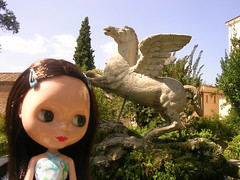
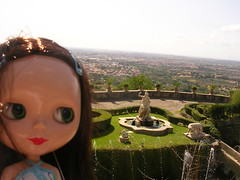
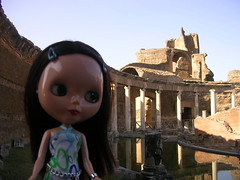
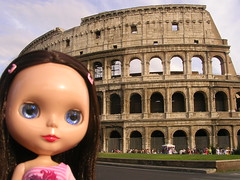

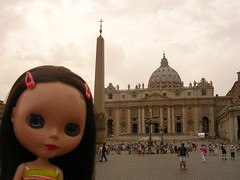

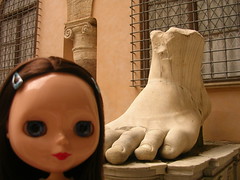


No hay comentarios:
Publicar un comentario